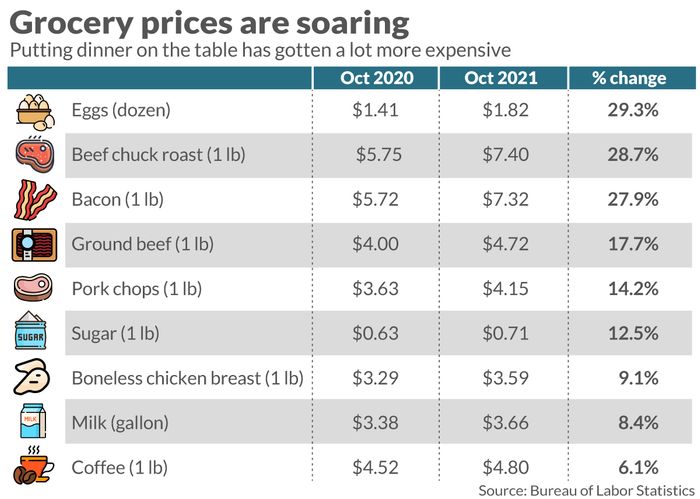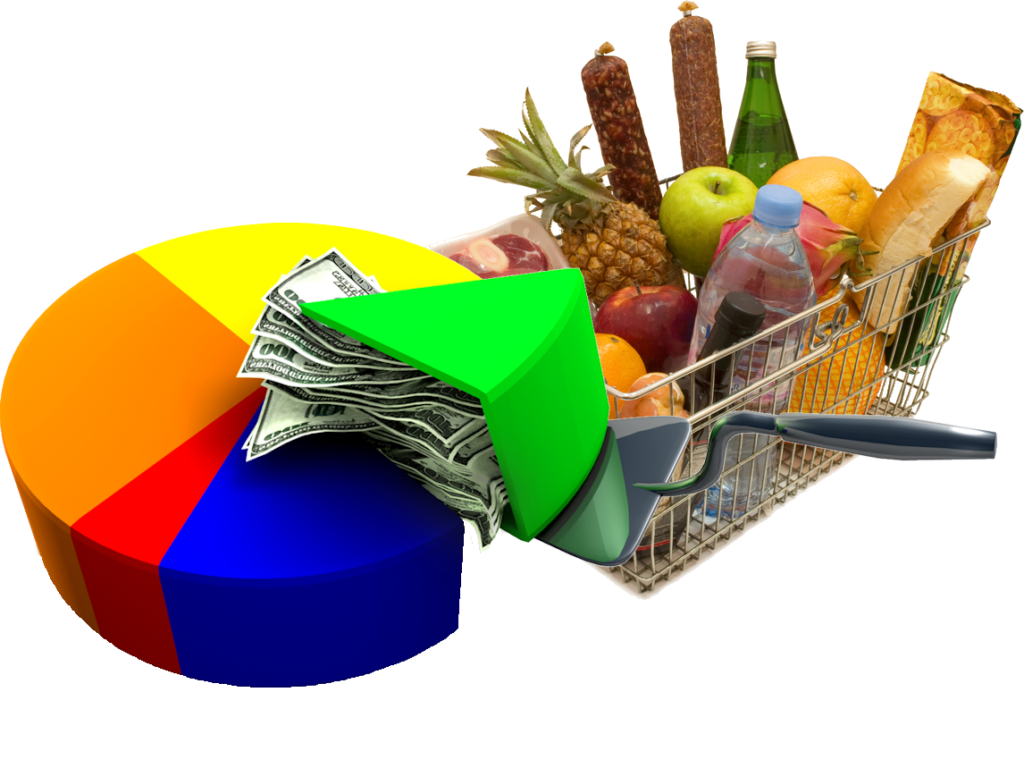For months, consumers have watched their budgets tighten as food prices have risen. Journalist Hillary Hoffower (@hillary_tweets) observes, “Americans’ pockets are hurting the most when it comes to food. Because groceries are everyday necessities, it makes sense that everyone is noticing the price of, say, milk going up more than anything else.”[1] Unfortunately, most pundits predict food prices will only continue to rise. Retail and grocery reporter Nathaniel Meyersohn (@nmeyersohn) writes, “Expect to keep paying more for groceries in 2022.”[3] His prediction is shared by the U.S. Department of Agriculture. The USDA predicts, “In 2022, food-at-home prices are expected to increase between 1.5 and 2.5 percent.”[2] If inflation continues on its current course, that prediction may be optimistic. Journalist Carol Ryan writes, “Confident consumers have swallowed higher supermarket prices so far this year, but the risk of indigestion is growing.”[3]
Inflation’s Impact on Consumers
Economics reporter Jeffry Bartash (@jbartash) observes, “Nothing makes Americans feel the impact of inflation as much as groceries, economists say. Most people shop for food at least several times a week, making it easier for them to see when prices rise.”[4] Using the following chart, Bartash demonstrated just how much some items have risen in cost over the past year.

Consumers looking for food bargains over the next few months shouldn’t hold their breath. Meyersohn reports, “Companies are pulling back on discounts on many items at stores because demand is strong and they don’t want to run out of their limited supplies of goods.” On the other, Ryan reports that consumer packaged goods manufacturers and grocery stores are trying to hold prices down because they risk losing market share as consumers go bargain hunting. “As a rule of thumb,” she reports, “price increases above 5% are harder to implement without changing [consumer] buying patterns, according to supermarket and consumer goods executives.”
What Consumers Can Do
Eric Lindberg, CEO of Grocery Outlet, told listeners on an earnings call that he expects inflation to push more shoppers to his company’s budget stores.[5] He noted that higher prices are “noticed by consumers [and] will cause them to change patterns or look for ways to save money.” Below are some recommendations consumers can use to help them keep grocery budgets in check.
Make a Shopping List. Journalist Lena Borrelli suggests, “It’s always better to plan than to go shopping blind. By taking the time to make a shopping list, you can help yourself stay on track and keep focused during your shopping trip.”[6]
Join a Loyalty Program. Almost every grocery chain offers a loyalty program and many of them have apps you can download that will provide information on current deals. Journalist Ana Staples writes, “Make sure you’re looking for savings wherever you can. For instance, take advantage of apps from stores like Target and Walmart. Such apps often have sections with discounts on grocery purchases.”[7]
Use Coupons. Although coupons may be more difficult to find as food supplies tighten, they can still be money-savers. Borrelli explains, “When you have a budget, it is also much easier to track weekly sales and specials on all of the things you need. Your local circular or newspaper will usually carry the latest sales, or you can subscribe to your favorite store’s mailing list, so you get the first word on sales before inventory runs out.”
Pay with a Cash-back Credit Card. One of the consequences of the pandemic is that more of us are using electronic payment methods. Staples suggests using the right credit card can help you save money. She explains, “Paying for your groceries with a credit card can be rewarding — if you’re using the right card. Many rewards credit cards earn cash back or points for every transaction, but there are a few cards that offer outstanding value when you use them for grocery purchases.”
Shop Alone. If you want to be single-minded and focused when you go shopping, then shop alone. “Your shopping trip is far more likely to be quicker and cheaper if you leave the little ones at home,” Borrelli writes. “Children are not likely to understand or appreciate the constraints of a budget, and you will likely appreciate the tantrum-free outing.”
Simplify Recipes. Celebrity professional chef Aaron Sanchez recommends “cooking tasty, but not pricey, meals.”[8] He also suggests that consumers keep a careful watch on what they may already have in their pantry “and focus on only buying essentials, like non-perishables, with longer shelf lives.” Finally, he suggests, “While you may be used to buying a specific cut of meat for just one dish, consider investing in larger amounts and different cuts that can be used for a variety of meals, including casseroles, stews and more, that can be made into larger quantities for multiple meals.”
Freeze and Store. Sanchez also notes, “While you may assume that fresh ingredients are always best, frozen versions can offer the same nutrients for a reduced cost and a longer shelf life.” Borrelli adds, “There is a reason why Costco and other wholesale clubs are so popular. The opportunity to buy in bulk can be a saving grace during times of financial hardship, with the price-per-serving significantly cheaper on a larger volume item than a smaller quantity.”
Keep to Your Budget. The whole point of making shopping lists, looking for bargains, and shopping alone is so that you can keep your food budget in check. It takes discipline. Borrelli writes, “Despite our best efforts, sometimes our planning falls by the wayside when we actually enter the store and become surrounded by tempting buys. While a shopping list is definitely helpful, take things one step further by tallying your bill while you shop. … By seeing the numbers increase while you shop, you’re far less likely to make impulse buys and exceed your grocery budget.”
Concluding Thoughts
Consumers will need to fend for themselves for the foreseeable future because there are a plethora of reasons food prices are likely to remain high. Hoffower explains, “The price hikes are the result of a lot of things: bad weather, a national labor shortage, and consumer demand that is no match for the supply chain right now. … Major droughts in countries like Brazil and Argentina have been driving up prices for corn, coffee, and soybeans. Meanwhile, grocery stores are scrambling to find workers and raising wages to lure them in, hikes that could be getting passed down in food costs.” By following the suggestions discussed above, consumers can save money. There is a downside to bulk shopping and storing, however, and that’s when such behavior becomes hoarding. Hoarding only increases inflationary pressures. If consumers shop wisely, hoarding isn’t necessary. The supply chain isn’t that broken.
Footnotes
[1] Hillary Hoffower, “Americans are pissed off they’re paying more for groceries these days,” Business Insider, 9 November 2021.
[2] Staff, “Summary Findings: Food Price Outlook, 2021,” U.S. Department of Agriculture, November 2021.
[3] Carol Ryan, “Inflation Is Approaching a Tipping Point at the Grocery Store,” The Wall Street Journal, 20 October 2021.
[4] Jeffry Bartash, “High inflation is eating up the budgets of American households,” MarketWatch, 12 November 2021.
[5] Meyersohn, op. cit.
[6] Lena Borrelli, “How to maximize savings on groceries,” Million Mile Secrets, 17 December 2020.
[7] Ana Staples, “Grocery shopping and COVID-19: What’s changed and how to save money,” Creditcards.com, 1 February 2021.
[8] Ibid.





